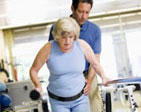
Stroke is the leading cause of long term disability in the United States with
only 14% of stroke survivors achieving full physical recovery (Gordon, 2004).
Survivors of stroke commonly have cardiovascular deficits predisposing them to
sedentary lifestyles and an increased risk for additional secondary
complications.
Literature Summary: Ambulatory stroke survivors may perform at 50% of
peak VO2 consumption compared to age matched healthy individuals (Gordon, 2004).
This makes performance of everyday tasks energetically expensive; limiting the
patient’s activity and participation within the community. Current evidence
suggests exercise trainability in stroke survivors is comparable to age matched
healthy counter parts (Gordon, 2004). Graded treadmill training at a moderate
intensity for 6 months has been shown to yield significant reductions in
submaximal energy expenditure in patients with chronic stroke (Macko, 2005).
Improvements in peak O2 consumption and blood pressure response have been
observed in as little as 10 weeks of vigorous aerobic training (3x/wk)
(Jorgensen, 2010). These findings suggest that a moderate to vigorous aerobic
training program may allow daily activities to be performed with less energetic
cost. The intensity of the training should be specific to the individual’s needs
and skill level. Progressive resistance training 2x/wk for 4 weeks has also been
shown to be effective in improving walking velocity, balance, and ADL
performance in this population (Cramp, 2010). Various exercise modes including
aquatic, bike, and upper extremity ergometery had similar training effects,
demonstrating the possible variability within a program to fit patient physical
ability and preference.(Jorgensen, 2010). Several authors suggest treadmill
training may provide carry over for improving ambulation ability while enhancing
cardiovascular fitness (Jorgensen, 2010;Gordon, 2004). Eight weeks of yoga
training has demonstrated improvements in scores of the stroke impact scale
(evaluation of cognitive, social, emotional and physical aspects of recovery),
Berg Balance Scale, and Timed Movement Battery indicating improvements in both
physical and emotional well being Bastille, 2004). A combination of resistance,
aerobic, flexibility, and relaxation training, such as yoga, will provide the
patient with the best variety for improvements in strength, endurance, balance,
and quality of life.
Clinical Application: Training for stroke survivors should be similar to
that of age matched healthy individuals emphasizing adequate intensity and
progression to safely challenge the cardiovascular system. A variety of modes,
dictated by the patient’s limitations and preferences, can be used to
effectively improve cardiovascular fitness which is linked to an increased
ability for ambulation, ADL execution, and a decreased risk for cardiovascular
diseases and recurrent stroke. A well-balanced training program for the stroke
survivor should include strength, aerobic, relaxation (such as yoga), and
flexibility training to best improve all aspects of physical and mental
wellness.
Last revised: September 12, 2011
by Bill Lyon, DPT, CSCS
References:
1)
Bastille, J., Gill-Body, K. (2004). A yoga-based exercise
program for people with chronic poststroke hemiparesis. Physical Therapy.
84(1), 33-48.
2)
Cramp, M., Greenwood, R., Gill, M., Lehmann, A., Rothwell, J., Scott, O.
(2010). Effectiveness of a community based low intensity exercise programme
for ambulatory stroke survivors.Disability and Rehabilitation 32(3), 239-
247.
3)
Gordon N, Gulanick M, Costa F, Fletcher G, Franklin B, Roth E, Shephard T.
(2004). PhysicalActivity and Exercise Recommendations for Stroke Survivors:
An American Heart
Association Scientific Statement from the Council on Clinical Cardiology,
Subcommittee on Exercise, Cardiac Rehabilitation, and Prevention; the
Council on Cardiovascular Nursing; the Council on Nutrition, Physical
Activity, and Metabolism; and the Stroke Council. Circulation. 109:
2031-2041.
4)
Jorgensen J, Pedersen D, Zeeman P, Sorensen J, Andersen L, Schonberger M.
2010. Effect of Intensive Outpatient Physical Training on Gait Performance
and Cardiovascular Health in People with Hemiparesis After Stroke. Physical
Therapy. 90 (4): 527-537.
5)
Macko R, Ivey F, Forrester L, Hanley D, Sorkin J, Katzel L, Silver K,
Goldberg A. 2005. Treadmill Exercise Rehabilitation Improves Ambulatory
Function and cardiovascular Fitness in Patients with Chronic Stroke: A
Randomized Controlled Trial. Stroke.36: 2206-2211.








